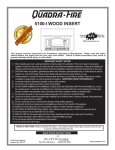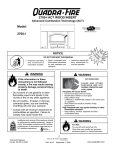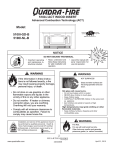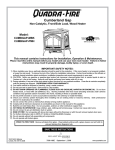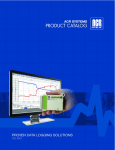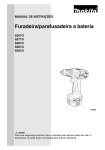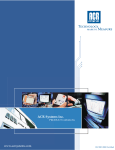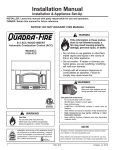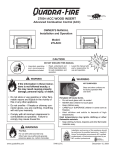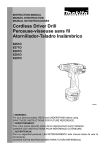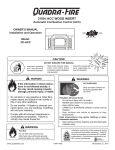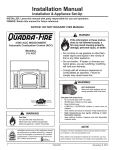Download Quadra-Fire 3100-I Owner`s manual
Transcript
R
3100-I ACT WOOD INSERT
Advanced Combustion Technology (ACT)
OWNER’S MANUAL
Installation and Operation
Beaverton
Oregon USA
Tested and
Listed by
C
US
OMNI- Test Laboratories, Inc.
Model:
830-0381
CAUTION
D
DI O N
SC O
AR T
D
DO NOT DISCARD THIS MANUAL
• Important operating
and maintenance
instructions included.
• Read, understand and
follow these instructions
for safe installation and
operation.
WARNING
WARNING
If the information in these
instructions is not followed
exactly, a fire may result causing
property damage, personal injury,
or death.
• Do not store or use gasoline or other
flammable vapors and liquids in the vicinity
of this or any other appliance.
• Do not overfire - If heater or chimney
connector glows, you are overfiring.
Overfiring will void your warranty.
HOT SURFACES!
Glass and other surfaces are
hot during operation AND
cool down.
Hot glass will cause burns.
•
•
•
•
Do not touch glass until it is cooled
NEVER allow children to touch glass
Keep children away
CAREFULLY SUPERVISE children in the same room
as appliance
• Alert children and adults to hazards of high
temperatures
High temperatures may ignite clothing or other
flammable materials.
• Comply with all minimum clearances to
combustibles as specified. Failure to
comply may cause house fire.
• Keep clothing, furniture, draperies and other
combustibles away.
Installation and service of this appliance should
be performed by qualified personnel. Hearth &
Home Technologies recommends NFI certified
professionals, or technicians supervised by an
NFI certified professional.
www.quadrafire.com
• Leave this manual with
party responsible for
use and operation.
250-6381D
WARNING
Fire Risk.
For use with solid wood fuel only.
Other fuels may overfire and generate
poisonous gases (i.e. carbon monoxide).
September 1, 2008
3100-I ACT WOOD INSERT
R
and Welcome to the Quadra-Fire Family!
Hearth & Home Technologies welcomes you to our tradition of
excellence! In choosing a Quadra-Fire appliance, you have our
assurance of commitment to quality, durability, and performance.
This commitment begins with our research of the market, including ‘Voice of the Customer’ contacts, ensuring we make products
that will satisfy your needs. Our Research and Development facility
then employs the world’s most advanced technology to achieve the
optimum operation of our stoves, inserts and fireplaces. And yet
we are old-fashioned when it comes to craftsmanship. Each unit
is meticulously fabricated and surfaces are hand-finished for lasting beauty and enjoyment. Our pledge to quality is completed as
each model undergoes a quality control inspection. We wish you
and your family many years of enjoyment in the warmth and comfort of your hearth appliance. Thank you for choosing QuadraFire.
SAMPLE OF SERIAL NUMBER / SAFETY LABEL
LOCATION: On right side of insert as face the appliance
WHILE IN OPERATION DO NOT TOUCH, KEEP CHILDREN AND CLOTHING AWAY.
CAUTION:HOT
CONTACT MAY CAUSE SKIN BURNS. KEEP FURNISHINGS AND OTHER COMBUSTIBLE
ATTENTION:
Tested and
Listed by
O-T L
Beaverton
Oregon USA
C
MATERIAL FAR AWAY FROM THE APPLIANCE. SEE NAMEPLATE AND INSTRUCTIONS.
CHAUD LORS DE L'OPÉRATION. NE PAS TOUCHER. GARDEZ LES ENFANTS ET LES VÊTEMENTS LOIN DE L'ESPACE
DÉSIGNÉ DE L'INSTALLATION. LE CONTACT PEUT CAUSER DES BRÛLURES À LA PEAU. GARDEZ LES MEUBLES ET LES
MATÉRIAUX COMBUSTIBLES LOIN DE L'ESPACE DÉSIGNÉ DE L'APPAREIL. VOIR L'ÉTIQUETTE ET LES INSTRUCTIONS.
OMNI-Test Laboratories, Inc.
Report #061-S-34-2
Model / Modèle:
3100-I ACT INSERT
R
Tested to / Testé a:
UL 1482, ULC S628
Installez et utilisez en accord avec les instructions d'installation et d'opération du fabricant. Contactez le bureau
de la construction ou le bureau des incendies au sujet des restrictions et des inspections d'installation dans
votre voisinage.
Référez vous aux instructions du fabricant et des codes locaux pour les précautions requises pour passer une
cheminée à travers un mur ou un plafond combustibles, et les compensations maximums.
Lorsque vous utilisez un poêle inséré fabriqué en briques, installez un foyer en briques fabriqué selon UBC
Chapitre 37. Ne pas enlever de la brique ou du mortier pour accommoder la pièce insérée. L'installation
demande un tuyau allant de la cheminée existante avec un couvert hermétique.
Installez seulement sur un foyer incombustible. Approuvé pour l'installation et l'usage dans les cheminées avec
espace libre de zéro, fabriquées en usine et se conformant aux spécifications minimum de chambre de feu
(États-Unis seulement).
Les pièces exigées pour l'installation: tuyau positif ou direct pour connexion de l'assemblée ou la doublure du
tuyau enregistré.
Au Canada, un tuyau doublé de grandeur de 6" S635 est exigé par le code ULC S628
PL
venting and operating instructions.
CONTACT YOUR LOCAL BUILDING OR FIRE OFFICIALS ABOUT
RESTRICTIONS AND INSTALLATION INSPECTION IN YOUR AREA
Refer to manufacturer's instructions and local codes for precautions
required for passing chimney through a combustible wall or ceiling.
When used as a masonry insert stove, install only in a masonry
fireplace built to UBC Chapter 37. Do not remove brick or mortar to
accommodate insert. Installation requires minimum of a starter pipe
into existing chimney with airtight face seal.
Install only on a non-combustible hearth. Approved for installation and
use in factory built zero-clearance fireplaces conforming to minimum
fire chamber specifications (USA only).
APPAREIL DE CHAUFFAGE DE PIÈCE, DE TYPE DE COMBUSTIBLE SOLIDE,
"Pour Usage Avec Bois Solide Seulement"
PRÉVENTION DES FEUX DE MAISON
Serial Number
Model Name
Test Lab & Report No.
E
LISTED ROOM HEATER, SOLID FUEL TYPE. "For Use with
Solid Wood Fuel Only." Also for use in Mobile Home.
PREVENT HOUSE FIRES
Install and use only in accordance with manufacturer's installation,
Serial No / Numéro De Série
007
Minimum Clearances To Combustible Material
Espaces Libres Minimum Des Matériaux Combustibles
SideWall / Mur de Côté
US Patents 4,766,876; 5,113,843; 5,341,794
Brevet US 4,766,876; 5,113,843; 5,341,794
Masonry, Heat Exchanger & *Zero Clearance
En briques, Circulant la chaleur & d'espace libre*
*Zero Clearance Installations USA Only
*Installation avec espace libre de zéro seulement aux États-Unis
Maximum Mantel Depth - 8" (203mm)
Profondeur Maximum de la Manteau de Cheminée - 8" (203mm)
B
MANTEL CLEARANCES / Espace Libre Manteau de Cheminée
Fascia or Trim /
Panneau ou Moulure
Insert
C
B
34"/867mm 30"/762mm
with 5" (127mm) Mantel Deflector
27"
23"
24"/610mm 21"/533mm
with 8" (203mm) Mantel Deflector
17"
16"
16"/406mm 14"/356mm
with Mantel Shield Only
24"
22"
18"/457mm 14"/356mm
23"
15"
15"/381mm 14"/356mm
déflecteur de cheminée de 8" (203 mm) etune protection de chemin 15"
12"
avec un déflecteur de cheminée de 8" (203 mm)
D
uniquement avec une protection de chemin
Pièce Insérée
F
5" (127mm) Deflector & Mantel Shield
E
déflecteur de cheminée de 5" (127 mm) etune protection de chemin
8" (203mm) Deflector & Mantel Shield
Hearth Extension / Extension de l'âtre
CANADA
C
30"
SA
A
USA/États-Unis
B
33"
*Pas de protection de cheminée
avec un déflecteur de cheminée de 5" (127 mm)
C
F
8"/203mm
D
6"/152mm
*No Mantel Shields
M
Mantel / Manteau de Cheminée
USA/États-Unis and CANADA
A
16"/406mm
15"/381mm 14"/356mm
Non-combustible floor protector must extend 8" (203mm) to
both sides. See chart for thermal protection requirements and FLOOR PROTECTION / PROTECTION DU PLANCHER
Thermal Protection USA & Canada
E E
Protection Thermique États-Unis & Canada
clearances for front hearth extensions.
Floor height 0" to 8" (0mm-203mm) below Insert Base 18" 18"/457mm
1 inch (25mm) of k=0.84
La protection de sol non-combustible doit être étendue à 8" (203 Hauteur du sol de 0” à 8” (0 mm à 203 mm) sous la base de l’insert
mm) de chaque côtés. Se référer aux tableaux des exigences de
protection thermique et distances minimales des extensions de la
protection sol frontale.
Manufactured by / Fabriqué par:
1445 N. Highway, Colville, WA 99114
www.quadrafire.com
Page Floor height greater than 8" (203mm) below Insert Base 16" 18"/457mm
Hauteur de sol supérieure à 8” (203 mm) sous la base de l’insert
1/2 inch (13mm) of k=0.84
U.S. ENVIRONMENTAL PROTECTION AGENCY - Certified to comply with July 1990 particulate emission standards.
2005 2006 2007 Jan
Feb Mar
Made in U.S.A. / Fait Aux États-Unis
Apr May June July Aug Sept Oct. Nov. Dec.
DO NOT REMOVE THIS LABEL / NE PAS ENLEVER L'ÉTIQUETTE
250-6381D
250-6392
Manufactured Date
September 1, 2008
R
3100-I ACT WOOD INSERT
TABLE OF CONTENTS
SAFETY & OVERVIEW OF APPLIANCE
MAINTENANCE
Serial Number /Listing Label Location------------------- 2
Dimensions------------------------------------------------------ 4
Minimum Clearances to Combustibles------------------- 5
Installation Recommendations----------------------------- 6
Listings & Safety Notices------------------------------------ 6
Chimney Height & Draft and 2-10-3 Rule--------------- 6
Installation Recommendations----------------------------- 6
General Installation Procedures--------------------------- 7
Alternate Floor Protection Worksheet-------------------- 7
Chimney Requirements-------------------------------------- 8
Ovalizing Round Stainless Steel Liners----------------- 8
Plated Surfaces------------------------------------------------ 18
Glass Cleaning & Replacement---------------------------- 18
Creosote Formation & Removal--------------------------- 18
Chimney---------------------------------------------------------- 18
Brick Replacement-------------------------------------------- 19
Baffle Removal------------------------------------------------- 19
Exploded Views------------------------------------------------ 20
PARTS & ACCESSORIES LISTS------------------------- 21-22
Service & Maintenance Log--------------------------------- 23-24
Homeowner’s Notes------------------------------------------ 25
Warranty Policy------------------------------------------------- 26-27
Contact Information------------------------------------------- 28
INSTALLATION OPTIONS
Masonry Fireplace--------------------------------------------- 9
Metal Heat Exchanger Masonry--------------------------- 9
Zero Clearance Factory Built Fireplace------------------ 10
Canadian Masonry & Heat Circulating------------------- 11
Leveling Bolts--------------------------------------------------- 11
Securing Liner to Chimney Ring--------------------------- 11
PARTS & ACCESSORY INSTALLATION
Panel & Trim Set----------------------------------------------- 12
Door Handle Assembly--------------------------------------- 12
Fan (Blower) Assembly-------------------------------------- 13
Fan Speed Adjustment--------------------------------------- 13
Zero Clearance Adjustable Trim Support---------------- 14
OPERATION OVERVIEW
Wood Selection & Storing----------------------------------- 15
Overfiring-------------------------------------------------------- 15
Building A Fire-------------------------------------------------- 15
Operating Tips-------------------------------------------------- 16
Burn Rates------------------------------------------------------ 16
Opacity----------------------------------------------------------- 16
Fan Operating Instructions---------------------------------- 16
Ash Removal--------------------------------------------------- 16
Air Quality------------------------------------------------------- 17
Air Controls, Primary and Start-up------------------------ 17
September 1, 2008
250-638D
Page 3100-I ACT WOOD INSERT
R
INSERT DIMENSIONS
27-7/16"
(697mm)
22-7/16"
(570mm)
TOP VIEW
CL
8-5/8"
(219mm)
5-3/8" (137mm)
14-1/8"
(359mm)
12-3/16"
(310mm)
38-7/8"
(987mm)
23-1/8"
(587mm)
SIDE VIEW
21-1/2"
(546mm)
20-3/8"
(518mm)
7-7//8"
(00mm)
26-1/4"
(667mm)
FRONT VIEW
A
Panel
A
B
Size
STD 44-5/8” 30-1/2”
Large
Page B
50-1/2” 34-1/2”
250-6381D
September 1, 2008
R
3100-I ACT WOOD INSERT
CLEARANCES TO COMBUSTIBLES
United States and Canada
Maximum Mantel Depth - 10" (254mm)
Mantel
SideWall
B
A
B
Fascia or Trim
C
A
Insert
F
D
E
C
Hearth Extension
*Zero Clearance Installations USA Only
In Canada a full length 6” (152mm) S635
flue liner required as per ULC S628.
NOTE: When installing into a masonry fireplace, the fireplace must be built to UBC
Chapter 37 standards. Do not remove brick
or mortar from masonry fireplace to accommodate insert. The permanent metal warning plate provided must be attached to the
back of the fireplace stating the fireplace
may have been altered to accommodate the
insert and must be returned to original condition for use as a conventional fireplace.
D
E
F
USA
Sidewall to Stove
16"
Mantel Clearances
*No Mantel Shield
33"
with 5" Mantel Deflector
27"
with 8" Mantel Deflector
17"
with Mantel Shield Only
24"
5" Deflector & Mantel Shield
23"
8" Deflector & Mantel Shield
15"
Top Trim to Stove
*No Mantel Shield
30"
with 5" Mantel Deflector
23"
with 8" Mantel Deflector
16"
with Mantel Shield Only
22"
5" Deflector & Mantel Shield
15"
8" Deflector & Mantel Shield
12"
Side Trim to Stove
6"
Hearth Extension-Front
Floor height 0" to 8" below Insert 18"
Floor height greater than 8"
16"
Hearth Extension-Side
8"
CANADA
16" (406mm)
34" (864mm)
24" (610mm)
16"(406mm)
18"(457mm)
15"(381mm)
15"(381mm)
30" (762mm)
21" (533mm)
14"(356mm)
14"(356mm)
14"(356mm)
14"(356mm)
6" (152mm)
18" (457mm)
18"(457mm)
8" (203mm)
Thermal Protection USA & Canada
Thermal protection must be ('k" value = 0.84) or equivalent material*
Floor height 0" to 8" below Insert 1 Inch (12.7mm) of "k" = 0.84
Floor height greater than 8"
1/2 inch (25mm) of "k" = 0.84
*See Alternative Floor Protection Worksheet on page 7.
The Mantel Shield must be comprised of a non-combustible material located a minimum of 1” (25mm) from mantel’s under side
extending to the full width of the mantel. The Mantel Deflector’s
are available from your dealer.
September 1, 2008
250-638D
Page 3100-I ACT WOOD INSERT
R
LISTINGS
CHIMNEY HEIGHT/DRAFT (CONT’D)
These installation instructions describe the installation and
operation of the Quadra-Fire 3100-I ACT Wood Insert. This
insert meets the U.S. Environmental Protection Agency’s 1990
particulate emission standards. The 3100-I ACTis listed by
OMNI-Test Laboratories, Inc. to UL Safety Standard 1482, and
ULC S628, and (UM) 84-HUD.
Check with your local building code agency before you begin your
installation to ensure compliance with local codes, including the
need for permits and follow-up inspections. Be sure local building
codes do not supersede UL specifications and always obtain a
building permit so that insurance protection benefits cannot be
unexpectedly cancelled. If any assistance is required during
installation, please contact your local dealer.
AVOID FIRE: To ensure that insulation or any other combustible
material does not contact the chimney, a chimney inside the house
must have at least 2 inches (51mm) of air space clearance around
the chimney. A chimney outside the house must have at least 1
inch (25mm) clearance to the combustible structure. Noncombustible fire stops must be installed at the spaces where the chimney
passes through floors and/or ceilings. Refer to Figures 8A & 8B
on page 8. Canadian installations require a full reline of the
chimney
NOTE: Clearances may only be reduced by means approved by
the regulatory authority having jurisdiction.
WE RECOMMEND that a qualified building inspector and your
insurance company representative review your plans before
installation.
CHIMNEY HEIGHT/DRAFT
To be sure that your Quadra-Fire insert burns properly, the chimney
draft (static pressure) should be approximately -0.10” water column
(W.C.) during a high burn and -0.04” W.C. during a low burn,
measured 6” (152mm) above the top of the insert after one hour of
operation at each burn setting.
NOTE: These are guidelines only, and may vary somewhat for
individual installations.
Your Quadra-Fire insert was designed for and tested on a 6”
(152mm) chimney, 12 ft-14 ft (360-420cm) high, measured from
the base of the insert. The further your stack height or diameter
varies from this configuration, the possibility of performance
problems increases. In addition, exterior conditions such as roof
line, surrounding trees, prevailing winds and nearby hills can
influence insert’s performance.
A masonry chimney or a listed factory-built UL103 HT Class “A”
chimney must be the required height above the roof and any other
nearby obstructions. The chimney must be at least 3 ft (91cm) higher
than the highest point where it passes through the roof and at least
2 ft (61cm) higher than the highest part of the roof or structure that
is within 10 ft (305cm) of the chimney, measured horizontally. See
2-10-3 Rule (Figure 6A). These are safety requirements and are
not meant to assure proper flue draft.
installation recommendations
The Quadra-Fire 3100-I ACT insert has met and surpassed the
most stringent emissions standards in the United States. The
sophistication of the interior firebox design requires that a proper
draft be supplied by the chimney, therefore adherence to the following factors will enable your insert to operate at its optimum capability.
required: A minimum starter pipe reaching to the base of the
existing code approved masonry chimney and an airtight face seal,
but a full chimney liner for factory-built fireplaces is recommended
for USA and is required in Canada.
better: Direct connection to the first flue liner in accordance with
the requirements of the NFPA 211.
best: A complete relining of the chimney system with a 6 inch
(152mm) diameter listed, stainless liner. Required for factory-built
fireplace installations in Canada, recommended in USA. The sections
must be attached to the insert and to each other with the crimped
(male) end pointing toward the insert. See Figure 6B. All joints,
including the connection at the flue collar, should be secured with
three sheet metal screws. Make sure to follow the minimum clearances to combustibles as set out on Page 5 of the manual.
LINER CONNECTOR
2-10-3 RULE
3 ft Min
(91cm)
2 ft Min (61cm)
CRIMPED
END
TOWARDS
STOVE
10 ft Min
(305cm)
FLUE
GAS
DIRECTION
Figure 6A
Figure 6B
Page 250-6381D
September 1, 2008
R
3100-I ACT WOOD INSERT
GENERAL INSTALLATION PROCEDURE
•
•
•
•
•
•
•
•
•
•
•
DO NOT CONNECT THIS UNIT TO A CHIMNEY FLUE SERVING ANOTHER APPLIANCE.
Install liner, if required, for your chosen installation.
Attach metal warning plate to the back of the fireplace with screws or nails.
Set appliance on the hearth (See Hearth Requirements page 5 and Support Kit information on page 14.
Complete the vent connection required for your installation type.
Install optional blower, if purchased, (page 13), then the panel set and finally the trim (page 12).
Position unit into fireplace leaving width enough for fiberglass batting to be inserted around face seal.
Work unit securely into the fireplace using sheet metal shims if leveling bolts are needed (page 11).
Remove all labels from glass prior to building first fire.
Ensure that plated surfaces are cleaned prior to building first fire (page 18).
Read Operation Instructions found on pages 15 and 16.
if installing this model to a masonry chimney, always be sure the chimney is in good condition and
that it meets the minimum standards of the national fire protection association (NFPA) standard 211.
A FACTORY BUILT CHIMNEY MUST BE 6 inch (152mm) UL 103 HT and ULC S629.
this appliance is made with a 6 inch (152mm) diameter chimney connector as the flue collar on the
unit. changing the diameter of the chimney can affect draft and cause poor performance. it is not
recommended to use offsets or elbows at altitudes above 4000 feet above sea level or when there
are other factors that affect flue draft. See page 6.
CAUTION: tHIS APPLIANCE IS HOT WHILE IN OPERATION AND MAY REMAIN SO UP TO 40 MINUTES AFTER THERE IS
NO FUEL IN THE FIREBOX. IF THIS APPLIANCE IS IN A HIGH TRAFFIC AREA OR CHILDREN MAY BE NEAR, IT IS RECOMMENDED THAT YOU PURCHASE A DECORATIVE BARRIeR TO GO IN FRONT OF THE APPLIANCE.
ALTERNATE FLOOR PROTECTION WORKSHEET
How to determine if alternate floor protection materials are acceptable:
All floor protection must be non-combustible (i.e., metals, brick, stone, mineral fiber boards, etc.). Any organic materials (i.e., plastics, wood paper
products, etc.) are combustible and must not be used. The floor protection specified includes some form of thermal designation such as R-value
(thermal resistance) or k-factor (thermal conductivity).
PROCEDURE:
1. Convert specification to R-value:
R-value given - no conversion needed.
k-factor is given with a required thickness (T) in inches: R =
1
k xT
K-factor is given with a required thickness (T) in inches:
1
R = K x 12 x T
r-factor is given with a required thickness (T) in inches: R =
2. Determine the R-value of the proposed alternate floor protector.
i. Use the formula in step (1) to convert values not expressed as “R”.
ii. For multiple layers, add R-values of each layer to determine overall R-value.
3. If the overall R-value of the system is greater than the R-value of the specified floor protector, the alternate is acceptable.
EXAMPLE: The specified floor protector should be 3/4 inch thick material with a k-factor of 0.84. The proposed alternate is 4” brick with an r-factor of
0.2 over 1/8” mineral board with a k-factor of 0.29.
1
xT
k
4" brick of R = 0.2, therefore:
1
x 0.75 = 0.893
.84
1/8" mineral board of k = 0.29, therefore:
R
R
Step (a): Use formula above to convert specification to R-value.
Step (b): Calculate R of proposed system.
brick
R=
= 0.2 x 4 = 0.8
R
total
=
mineral board
=
1
x 0.125 = 0.431
0.9
=R
+R
= 0.8 + 0.431 = 1.231
brick
mineral board
Step (c): Compare proposed system Rtotal of 1.231 to specified R of 0.893. Since proposed system Rtotal is greater than required, the system is acceptable.
(ft )(hr)(oF)
Btu
2
R=
September 1, 2008
k = Btu(in) = K x 12
2
ft (hr)(oF)
K=
Btu(ft)
2
o
ft (hr)( F)
250-638D
2
o
r = (ft )(hr)( F)= 1
k
(Btu)(in)
Page 3100-I ACT WOOD INSERT
R
CHIMNEY REQUIREMENTS
A chimney must be the required height above the roof
or other obstruction for safety and for proper draft operation. The requirement is that the chimney must be at
least 3 feet (91cm) higher than the highest point where
it passes through the roof, and at least 2 feet (61cm)
higher than the highest part of the roof or structure that
is within10 feet (305cm) of the chimney, measured horizontally. Refer to Figure 8C.
Figure 8A
OVALIZING ROUND STAINLESS STEEL
LINERS
Ovalizing round stainless steel liners to acommodate
the liner passing through the damper region of a fireplace is an allowable and acceptable practice.
Ensure that the ovalization is minimized to the extent
required to fit through the damper.
Figure 8C
Firestopping
Non-Combustible
Firestopping
Material
CHIMNEY HEIGHT
10 ft
(305cm)
Floor
inch
(51mm)
At least 3 ft
(91cm)
Ceiling
At least ft
(61cm)
Caulk
Floor
(second Story)
Minimum 1 inch (25mm)
clearance from exterior
chimney to sheathing
Figure 8D
Figure 8B
Minimum 2 inch (51mm) clearance
from combustible material
and insulation
CHIMNEY TOP VIEW
1/2" (12.7mm) airspace
ceiling
FLUE
Non-combustible
fire stopping material
5/8" (16mm)
Fireclay Flue
Liner
Chimney Wall
4" (102mm)
Nominal
Foundation
Page 250-6381D
September 1, 2008
R
3100-I ACT WOOD INSERT
INSTALLATION OPTIONS
Refer to: Clearances to Combustibles on page 5, Canadian Installation requirements on page 11,
Hearth Requirements on page 5 and Zero Clearance Adjustable Support Kit on page 14.
MASONRY FIREPLACE
USING DIRECT-CONNECT METHOD
Full Listed
Masonry Chimney
Flue Tile
The Quadra-Fire 3100-I ACT Insert conforms with the UL
Standard for Safety 1482 and ULC S628 (Canada) in all
respects, and is approved to UL & ULC safety standards
for installation and use within a fireplace with a masonry
chimney in accordance with NFPA No. 211, with or without
a direct flue collar connection. A starter pipe is required to
reach to the bottom of the existing flue.
Liner Option
Mantel
Air-tight Face Seal
Damper Area
Direct Connect
Seal Option
Minimum Starter
Pipe Option
1. Secure the fireplace damper in the open position. If this
cannot be accomplished, it will be necessary to remove the
damper.
2. Seal the damper area around the chimney liner with a
high temperature sealant.
3. The chimney should be examined for cracks, loose mortar,
and other signs of deterioration and blockage. The insert
should not be installed until it is determined that the chimney is safe for use. Since an oversized flue contributes to
the accumulation of creosote, the size of the flue should be
checked to determine that it is not too large for the insert.
The chimney should also be checked to ensure it meets the
minimum standard of the National Fire Protection Association (NFPA) Standard 211. The following bullets list the more
critical requirements for a properly constructed chimney:
• The masonry wall of the chimney, if brick or modular
block, must be a minimum of 4 inches (102mm) nominal
thickness. A chimney of rubble stone must be at least 12
inches (305mm) thick
SEAL DAMPER AREA OR FACE SEAL
Figure 9A - Installation Into Masonry Fireplace
METAL HEAT CIRCULATING masonry
The Quadra-Fire 3100-I Insert conforms with the safety standard UL-1482 and ULC S628 (Canada) in all respects and is
approved to UL & ULC safety standards for installation and
use within a fireplace with masonry chimney, in accordance
with NFPA No. 211, with or without a direct flue collar connection. A starter pipe is required into existing chimney.
• The chimney must have a fire clay flue liner (or equivalent) with a minimum thickness of 5/8” (16mm) and must be
installed with refractory mortar. An equivalent liner must be
a listed chimney liner system or other approved material.
Mantel
Listed Liner
• A chimney inside the house must have at least 2 inches
(51mm) of clearance to the combustible structure. A chimney outside the house must have at least 1 inch (25mm)
clearance to the combustible structure. Non-combustible fire
stops must be installed at the spaces where the chimney
passes through floors and/or ceiling (See Figure 8A and 8B
on page 8).
NOTE: In Canada, a full reline is required.
SEAL DAMPER AREA OR FACE SEAL
Figure 9B
September 1, 2008
250-638D
- Installation Into Metal Heat Circulating
Showing Use Of Starter Pipe
Page 3100-I ACT WOOD INSERT
R
Factory built zero clearance fireplace
(usa installations only)
The Quadra-Fire 3100-I ACT Wood Stove Insert is listed to
UL 1482 Standard and approved for installation into listed
factory built zero clearance fireplaces listed to UL 127 conforming to the following specifications and instructions:
Mantel
The original factory-built clearance fireplace chimney cap
must be re-installed after installing the approved chimney liner meeting type H.T. requirements (2100°F) per UL
1777. The air flow of the factory-built zero-clearance fireplace system must not be altered. The flue liner top support
attachment must not reduce the air flow for the existing aircooled chimney system.
Listed Liner
NOTE: Refer to chimney liner manufacturer for recommendations on supporting the liner.
Minimum Width of cavity opening:
32 in.
Minimum Height:
23 in.
Minimum Depth from front to rear:
16 in.
The following modifications of factory built fireplaces are
permissible: 1) removal of damper; 2) removal of smoke
shelf or baffle; 3) removal of ember catches; 4) removal
of fire grate; 5) removal of viewing screen/curtain; and, 6)
removal of doors.
NOTE: Installation into fireplaces without a permit
will void the listing.
The factory built chimney must be listed per UL 127 and
meet the type HT requirements of UL 103. Factory built
fireplace chimneys tested to UL 127-1998, may be at the
fireplace manufacturer’s option, tested to the same criteria
as UL 103 HT requirements. If the chimney is not listed
as meeting HT requirements, or if the factory built fireplace was tested prior to 1998, a full height listed chimney
liner must be installed from the appliance flue collar to the
chimney top. The liner must meet type HT requirements
(2100ºF) per UL 1777.
SEAL DAMPER AREA OR FACE SEAL
Figure 10A - Installation into a Factory Built Zero
Clearance Fireplace
The permanent metal warning label provided must be
attached to the back of the fireplace, with screws or nails,
stating that the fireplace may have been altered to accommodate the insert, and must be returned to original condition
for use as a conventional fireplace.
If the hearth extension is lower than the fireplace opening,
the portion of the insert extending onto the hearth must be
supported. Manufacturer designed adjustable support kit
can be ordered from your dealer. (See page 14).
Final approval of this installation type is contingent upon
the authority having jurisdiction.
The liner must be securely attached to the insert flue collar
and the chimney top. To prevent room air passage to the
chimney cavity of the fireplace, seal either the damper area
around the chimney liner with high temperature sealant or
the fireplace front with fiberglass batting.
The fireplace must not be altered, except that the damper
may be removed to accommodate a direct-connect starter
pipe or chimney liner, and external trim pieces which do
not affect the operation of the fireplace may be removed
providing they can be stored on or within the fireplace for
reassembly if the insert is removed.
Page 10
250-6381D
WARNING
Fire Risk.
When lining air-cooled factory-built chimneys:.
• Run chimney liner approved to UL 1777 Type
HT requirements (2100 degrees F)
• Re-install original factory built chimney cap
ONLY
• DO NOT block cooling air openings in chimney
• Blocking cooling air will overheat the chimney
September 1, 2008
R
3100-I ACT WOOD INSERT
INSTALLATION IN CANADA
MASONRY and HEAT-CIRCULATING
(INSTALLATIONS INTO FACTORY-BUILT FIREPLACES ARE PROHIBITED IN CANADA)
Whether installed in a masonry or heat-circulating fireplace, this fireplace insert must be installed with a continuous chimney liner of 6” (152mm) diameter extending from the fireplace insert to the top of the chimney. The chimney liner must
conform to the Class 3 requirements of CAN/ULC-S635, Standard for Lining Systems for Existing Masonry or Factory-Built
Chimneys and Vents, or CAN/ULC-S640, Standard for Lining Systems for New Masonry Chimneys.
• Do not remove bricks or mortar from fireplace to accommodate insert.
• The face of the fireplace must be sealed to prevent room air passage into the chimney cavity.
• The permanent metal warning label provided must be affixed to the back of the fireplace with screws or nails to
the fireplace, in a location readily visible should the fireplace insert by removed, stating that the fireplace may
have been altered to accommodate the insert, and must be returned to original condition for use as a conventional fireplace.
NOTE:
In Canada when using a factory-built chimney it must be
safety listed, Type UL 103 HT CLASS "A" or conforming
to CAN/ULC-S629, STANDARD FOR 650°C FACTORYBUILT CHIMNEYS.
Use of Leveling Bolts
Two leveling bolts, 3/8” x 4” are shipped inside the component pack found inside the firebox.
NOTE: Not all installations will require the use of the leveling bolts. If the leveling bolts are necessary, you will also need
sheetmetal guides placed under the leveling bolts to slide insert into position.
1. Remove the bolts from the component pack.
2. Locate the cage nuts welded to each side of the insert bottom and insert bolts.
3. Position insert on hearth with rear of insert extending into fireplace opening.
4. Extend leveling bolts downward to level insert.
SECURING LINER TO CHIMNEY RING
There are two options to secure the liner to the chimney
ring: (See Figure 11A).
Option One: If there is enough room on the top of the
insert to work, hand bend the two tabs upward 90°.
Secure the liner with the supplied hex head bolts 1/420-3/4.
Option Two: Remove the manifold tubes, fiberboard baffle
and ceramic blanket. From inside the firebox, pull liner
down through the chimney ring below the outer skin.
There are two pre-drilled holes in the chimney ring 180°
apart. Secure the liner with the supplied hex head bolts
1/4-20-3/4.
NOTE: Tabs are shipped from factory in a flat position.
Bend upwards 90 degrees.
September 1, 2008
250-638D
2 pre-drilled holes on
chimney ring under outer skin
(access through firebox)
Attach liner with tab
s
Figure 11A
Page 11
3100-I ACT WOOD INSERT
R
INSTALLATION OF PANEL SET AND TRIM
Part No.
Description
831-0862 Large, Gold
Part No.
Size
Description
Size
SP-31S-NL Std, Nickel 44-5/8” x 30-1/2”
SP-31L-NL Large, Nickel 50-1/2” x 34-1/2”
50-1/2” x 34-1/2”
Kit Includes: (2) Side Panels, left & right; (1) Panel Top & Fastener package; (2) Side Trim, left & right; (1) Trim Top &
Fastener package.
Tools Needed: Powered Phillips head screw driver.
Attaching Panels to the Insert
1. Install the 2 side panels on the insert first, using the cage nuts already attached to the stove, pushing panels away from the
insert to the maximum distance of the slot. See Figure 12A. (Note: The sides are interchangeable).
2. Put on the top panel and push straight back. Attach the top panel to the sides using the screws and the panel brackets found in
the fasteners package. Now move the side panels inwards (toward insert) into position and tighten screws.
Assembling Trim
1. Place protective covering on surface to be used to assemble the trim pieces. Lay the trim face down.
2. Attach the 2 side trim pieces to the top trim at each corner using the “L” bracket included in fasteners package. Slide assembled
trim over panel set. See Figure 12B.
View of "L" Bracket
installed
View of “L” Bracket Installed
Panel brackets
Install sides and push out to
maximum distance of slot.
Adjust position by sliding
left or right after top is in
place.
Figure 12B
Figure 12A
DOOR HANDLE ASSEMBLY
1.
2.
3.
4.
5.
Install washer on door handle shaft.
Slide door handle through door.
Install second washer(s) as shown.
Install key in groove.
Align groove in latch cam with key; slide
latch cam over shaft.
6. Install locknut.
Caution! Do not overtighten locknut.
Door handle needs to move smoothly.
7. Install spring handle turning counterclockwise to desired location on handle.
Latch Cam
Door Cross Section
(example)
Locknut
Spring
Handle
Door Handle
Spacing
Washers
Square Key
Page 12
250-6381D
September 1, 2008
R
3100-I ACT WOOD INSERT
FAN (BLOWER) INSTALLATION INSTRUCTIONS
Part No. 831-1101
Black & White Wires Attach
to Fan Motor Terminals
Speed Control
Power Cord
Strain Relief Location,
Holding Together Power
Cord and Fan Motor
Wires
Screens
(Fan Covers)
Feed Fan Motor
Wires Through Holes
Included in Kit: (2) Fan mounts & fan assemblies; (1)
Speed Control, Power Cord/wire assembly; (1 set) Fan
Connector wires, must be high temperature wire; and (1)
Strain relief.
Tools Needed: Large Phillips screwdriver, pliers
1. Remove Screens (fan covers).
2. Install fan mounts to outer wall with panel mounting
screws.
3. Feed fan and motor wires up through large hole in floor.
NOTE: Power cord can be mounted on left or right side.
4. Connect white and black wires to fan motor terminals
and the green ground wire to ground terminal
5. Feed fan motor wires through holes in bottom and
across to the other fan motor.
6. Install strain relief onto power cord.
7. Using a pair of pliers, squeeze strain relief and push
through hole.
8. Plug in and test blower operation.
9. Replace Screens.
10.Route power cord away from the unit. DO NOT route
power under or in front of unit.
September 1, 2008
Power cord can
be attached to
the right or left
side.
FAN SPEED CONTROL ADJUSTMENT, IF
NECESSARY*
*The fan Speed Control for this unit is adjusted at
the factory, and normally does not require further
adjustment.
NOTE: When the speed control is turned clockwise,
it will click on to high speed. Continue to turn the
speed control clockwise to decrease the speed. At
full clockwise, the blower should blow gently, but
should not stop.
1. With the unit plugged in, turn the Speed Control
Knob to slow. (Full clockwise.)
2. Use a small screwdriver to adjust the fan speed by
turning the adjustment mechanism through the hole
on the side of the Speed Control.
3. Adjust the speed so the fan runs slowly but does not
stop. Turn clockwise to slow the fan and counterclockwise to increase the speed.
250-638D
Page 13
R
3100-I ACT WOOD INSERT
ZERO CLEARANCE ADJUSTABLE TRIM SUPPORT, 2” to 10”
Part No. 841-0990, size 9” x 45” and Part No. ADJSPT-12, size 12” x 50”
Included in Kit: (1) Trim Top, (1) Trim Front, (2) Trim Sides, Double-Sided Tape (already installed)
Tools Needed: Phillips Head Screwdriver, Sheet Metal Shears, Measuring Tape, Gloves
1. The 10 screws on each set of scissors will already be
loose when shipped. See Figure 14A.
EXPLODED VIEW OF SCISSORS
2. Expand scissors to desired height. Tighten screws
to hold in place using Phillips Head screwdriver. See
Figure 14B.
3. Measure front and side trims to required height to cover
scissors and mark pieces for cutting. Cut excess material from top of trim’s edge, not bottom. This edge will
be sharp; wear gloves to prevent injury to your hands.
See Figure 14B.
SCREWS ARE CIRCLED
DOUBLE-SIDED TAPE
DOUBLE-SIDED TAPE
Figure 14A
EXPAND SCISSORS TO DESIRED HEIGH T
4. Using sheet metal shears, cut trim along the marked
edge. The cut edge fits under lip of top trim, so it
allows for some variance in your straight edge.
5. The double-sided tape that holds front and side trims
to scissors has a particularly powerful bonding adhesive. Adjustments are extremely difficult once trim has
adhered to tape. Do a dry run first without removing
paper from tape.
6. Place cut edge of trim under top lip and into position
on scissors. Place side pieces on first and then front
piece. The front piece overlaps side pieces. NOTE:
The trim in the Flush Mount Kit is one piece.
7. Once you are satisfied with the positioning, remove
trim and set aside.
8.
Remove the paper from double-sided tape that is
to accept trim side. Align side and then press hard
against tape to secure side piece. Repeat for other
side. Install front trim piece last.
9. There are 3 holes in the back flange of the top to
secure it to the wall if necessary. Use the appropriate
fastener for the type of wall material, i.e., brick, sheetrock, etc.
INSTALL FRONT TRIM LAST.
CORNERS OVERLAP SIDE
TRIM PIECES
CUT TOP EDGE OF TRIM,
NOT BOTTOM EDGE
Figure 14B
Decorative tile may
be installed
Figure 14C
NOTE: 3/8” ( 9.5mm) thick tile or like material can be cut
to size and fit under lip of top trim edge for a decorative touch. See Figure 14C.
Figure 14D
Page 14
250-6381D
September 1, 2008
3100-I ACT WOOD INSERT
R
OPERATION
WOOD SELECTION AND STORAGE
Burn only dry seasoned wood. Dry, well-seasoned wood will not only minimize the chance of creosote formation but will give you the
most efficient heat output. Even dry wood contains at least 15% moisture by weight and should be burned hot enough to keep the
chimney hot enough to maintain particulate (smoke) burning. Burning unseasoned wood of any variety defeats the stoves’ efficiency.
Dead wood lying on the forest floor should be considered wet, and requires full seasoning time. Standing wood can be considered to be
about two-thirds seasoned. Wood is dry enough to burn if the ends of the logs have cracks radiating in all directions from the center. If
your wood sizzles in the fire, even though the surface is dry, it may not be fully cured.
Drying time can be reduced by splitting wood prior to storage. Since the majority of drying occurs through the cut ends rather than the
sides, stack the wood so both ends of each piece are exposed to air. Store wood under cover, such as in a shed, or covered with a tarp,
plastic, tarpaper, sheets of scrap plywood, etc.
OVERFIRING
Do not overfire. Overfiring can result in crazing, an effect causing a white, non-removable film to be deposited on the inside of the glass.
Using flammable liquids or too much wood, or burning trash in the insert, may result in overfiring. If the chimney connector or insert
glows red, or worse, white, the insert is overfired. This condition may ignite creosote in the chimney, possibly causing a house fire. If any
part of the insert starts to glow, you are in an overfire situation. If you overfire, immediately close the insert dampers and door, if open,
to reduce the air supply to the fire. Overfiring your insert voids your warranty.
BUILDING A FIRE
NOTE: Remove all labels from glass front prior to lighting the first fire.
Before lighting your first fire in the insert, make certain that the baffle is correctly positioned. It should be resting against the rear support.
Also refer to care and cleaning of plated surfaces on page 18 before lighting your first fire.
CAUTION: Never use gasoline, gasoline-type lantern fuel, kerosene, charcoal lighter fluid, or similar liquids to start or “freshen
up” a fire in this heater. Keep all such liquids well away from the heater while it is in use.
There are many ways to build a fire. The basic principle is to light easily-ignitable tinder or paper, which ignites the fast burning kindling,
which in turn ignites the slow-burning firewood. Here is one method that works well:
1. Place several wads of crushed paper on the firebox floor. Heating flue with slightly crumpled newspaper before adding
kindling keeps smoke to a minimum.
2. Place several wads of crushed paper on the firebox floor.
3. Open Start-Up Air Control (right side) and Primary Air Control (under ashcatcher) fully. See Figure 17A on page 17.
4. Ensure that no matches or other combustibles are in the immediate area of the insert, that the room is adequately ventilated,
and the flue is unobstructed.
5. Light the paper in the insert. NEVER light or rekindle insert with kerosene, gasoline, or charcoal lighter fluid; the results
can be fatal.
6. Once the kindling is burning quickly, add several full-length logs 3” (76mm) or 4” (102mm) in diameter. Be careful not to
smother the fire. Stack the pieces of wood carefully: near enough to keep each other hot, but far enough away from each
other to allow adequate air flow between them.
7. When ready to reload the insert, add more logs. Large logs burn slowly, holding a fire longer. Small logs burn fast and
hot, giving quick heat.
8. Adjust the Start-Up Air Control and Primary Air Control, maintaining flames above the fuel. The more you close down the Primary
Control, the lower and slower the fire will burn. The more you open the Primary Control the more heat will be produced. The
Start-Up Air Control (right side) is only used for the first 5 to 15 minutes.
As long as there are hot coals, repeating steps 7 and 8 will maintain a continuous fire.
NOTE: The special high temperature finish paint applied to the insert will cure as your insert heats. You will notice an odor
and perhaps see some vapor rise from the insert surface, this is normal. We recommend that you open a window until the odor
dissipates and the paint is cured.
September 1, 2008
250-638D
Page 15
R
3100-I ACT WOOD INSERT
OPERATING TIPS
For maximum operating efficiency with the lowest emissions, follow these operating procedures:
1. Regardless of desired heat output, when loading your insert, burn your Quadra-Fire with both air controls wide open for a
minimum of 5 to 15 minutes.
2. Regulate burn rate (heat output) by using the Primary Control (located under the ashlip). The Start-Up Air Control (right side)
is mainly for initial start-up and reloading.
3. Heat output settings: Follow Burn Rate Instructions listed below.
4. Burn only dry, well-seasoned wood.
WARNING: Do not operate with Start-Up
Air Control in the open position in excess
of 15 minutes! Risk of extreme temperatures! Prolonged operation of this stove
with the Start-Up Air Control in the open
position may cause the combustible materials around the stove to exceed safe temThese are approximate settings, and will vary with type of wood or chimney draft. perature limits.
BTU / Hr
Below 10,000
10,000 - 15,000
15,000 - 30,000
Maximum Heat
Start-Up Air Control
Closed after 5 to 15 minutes
Closed after 5 to 15 minutes
Closed after 5 to 15 minutes
Closed after 5 to 15 minutes
Primary Control
Pull to Stop
1” - 1-1/4” open
1-1/4” - 2-1/2” open
Fully open
BURN RATES
STARTING FIRE: Open both controls (push in) completely. After a wood load has been burning on high for 5 to 15 minutes or longer for
very large pieces, close the Start-Up Air Control (right side) by pulling it out.
HIGH: Leave the Primary Air Control fully open (immediately under the ashcather). It is especially important to fully open both controls
when reloading the insert as failure to do so could result in excessive emissions, also referred to as ‘opacity’.
After a wood load has been burning for 5 to 15 minutes on High to achieve the following burn rates set the controls
as listed below:
MEDIUM HIGH: Close the Primary Air Control to 1-1/4” to 2-1/2” (32mm to 64mm) open. Start-Up Air is closed.
MEDIUM: Close the Primary Air Control to 1” to 1-1/4” (25mm to 32mm) open. Start-Up Air is closed.
LOW: Gradually close down the Primary Air Control by pulling out making sure to maintain flames in the insert. (Start-Up Air is closed).
It is very important to maintain flames in your insert during the first few hours of a low burn to avoid excessive air pollution.
OPACITY
Opacity is the measure of how clean your insert is burning and is measured in percentages. An opacity of 100% in the smoke column
from a chimney will totally obscure an object. Whereas 0% opacity means that no smoke column can be seen. A periodic check of the
opacity emitted from your chimney will enable you to burn your insert as smoke free as possible.
fan operating instructions
1. Initial (cold) startup: Leave fan off until your insert is hot and a good coal bed is established, approximately 30 minutes after fuel
is lit.
2. High Burn Setting: The fan may be left on throughout the burn.
3. Medium or Medium High Burn Setting: The fan should be left off until a good burn is established, then turned on a medium
or high rate.
4. Low Burn Setting: The fan tends to cool the insert. Leave fan off until the burn is well established; then, if you wish, turn the fan
on at a low rate.
5. The fan is equipped with a rheostat (speed control). The highest fan speed is obtained by turning the rheostat on, then adjusting back
towards “OFF” as far as possible without turning the fan off. For a low fan speed, turn the control knob clockwise as far as possible.
ASH REMOVAL
Remove cold ashes (not hot) from the insert at regular intervals, depending on your usage. Ashes should be placed in a metal container
with a tight fitting lid. The closed container of ashes should be placed on a non-combustible floor or on the ground, well away from all
combustible materials, pending final disposal. If the ashes are disposed of by burial in soil or otherwise locally dispersed, they should be
retained in the closed container until all cinders have thoroughly cooled. Always treat ashes as if they contain hot coals.
Page 16
250-6381D
September 1, 2008
R
3100-I ACT WOOD INSERT
air quality AND your Quadra-Fire Insert
In recent years there has been an increasing concern about the quality of our air. Much of the blame for poor air quality has
been placed on the burning of wood for home heating. In order to improve this situation we at Quadra-Fire have developed
cleaner burning inserts that surpass the stringent requirements for emissions established by our governing agencies. Your
3100-I ACT, like any other appliance, must be properly operated in order to insure that they perform the way they are
designed to perform. Improper operation and maintenance may cause any wood burning unit to release more particulate,
adversely affecting the environment.
The story of the Three Burning Stages . . .
It helps to know a little about the actual burn process, which entails three discernible burning stages. The first stage
is called the kindling stage. During this stage the fuel reaches the boiling temperature of water, 212°F, evaporating the
moisture found to some degree in all wood.
Because the process takes heat from the insert during this initial drying stage, each new load of wood reduces the chances
for a good, clean burn. For this reason it is always best to burn dry, seasoned firewood, and operate the controls properly.
The control on the right side of your insert is called the Start-Up Air Control and is used primarily during this first kindling
stage of burning.
During the secondary stage, the wood gives off flammable gases which burn above the fuel with bright flames. These
flames above the fuel must be maintained until the third stage to insure proper burning. During this stage you may adjust
your insert for a low burn rate. To achieve a low burn rate it is necessary to close down the air while still maintaining some
flames. If the flames tend to go out, the setting is too low. The Primary Control, located in the center of the insert beneath
the ashcatcher, will assist you in adjusting the insert for a low burn rate.
The third stage of burning is the charcoal stage. This happens when the flammable gases have been burned and the
charcoal remains. The coals burning with hot blue flames is a naturally clean portion of the burn. It is very important to
reload your insert while enough lively hot coals remain in order to provide the amount of heat needed to dry and rekindle
the next load of wood. Open up both controls for a short while before reloading to liven up the coal bed. You should also
break up any large chunks and distribute the coals so the new wood is laid on hot coals. Leave both controls open until
the new wood load is burning well enough to maintain the secondary stage of burning and then set controls to your desired
heat output setting.
START-UP AIR SYSTEM
The combustion air enters at the rear of the firebox through the rear air tubes. This air supply is controlled by the Start-Up
Air Control.
PRIMARY AIR SYSTEM
The primary air enters at the upper front of the firebox near the top of the glass door. This preheated air supplies the
necessary fresh oxygen to mix with the unburned gases, helping to create secondary, tertiary and quaternary combustion.
This air is regulated by the Primary Air Control. For more primary air (more heat), push rod in. For less primary air (less
heat), pull rod out.
In other words . . .
Pulling either control towards you closes off the air available to the insert in that area. Pushing either control opens it, allowing air circulation to the area. A good analogy to remember for this procedure is the gas pedal on your car. Pushing in the
gas pedal makes the engine run faster. Letting off (pulling the control back) makes the car run slower.
OPEN - PUSH IN
Figure 17A
September 1, 2008
CLOSE - PULL OUT
Primary Air Control
Start-Up Air Control
250-638D
Page 17
R
3100-I ACT WOOD INSERT
MAINTENANCE
CARE AND CLEANING OF PLATED SURFACES
IMPORTANT: You must clean all the fingerprints and oils from the plated surfaces before firing the insert for the first time.
Use warm soapy water and a soft rag, glass cleaner and a paper towel, or vinegar and a paper towel to remove the oils.
DO NOT use abrasive cleaners! If not cleaned properly prior to lighting the first fire, the oils can cause permanent stains.
The plating will be cured upon firing of the insert and oils will no longer affect the finish. Subsequently, little maintenance
is then required. Wipe clean as needed with a soft towel.
CARE AND CLEANING OF GLASS
NOTE: Remove all labels from glass prior to lighting the first fire.
Quadra-Fire inserts are equipped with super heat resistant ceramic glass which can only be broken by impact or misuse.
Clean glass with any non-abrasive glass cleaner. Abrasive cleaners may scratch and cause glass to crack. Inspect glass
regularly. If you find a crack or break, immediately put the fire out and return the door to your authorized dealer for replacement of glass before further use. Do not substitute materials for glass replacement.
WARNING! DO NOT SLAM INSERT DOOR OR
IMPACT THE GLASS WHEN CLOSING THE DOOR,
MAKE SURE THAT LOGS DO NOT PROTRUDE
AGAINST THE GLASS.
WARNING! DO NOT OPERATE WITH BROKEN
GLASS.
WARNING! DO NOT CLEAN GLASS WHEN HOT.
GLASS REPLACEMENT INSTRUCTIONS
Replace with 5mm ceramic glass only
1.
2.
3.
4.
5.
Remove door from insert and lay on a padded flat surface.
Remove glass retainer screws using a Phillips screwdriver.
Lift glass out of the door frame.
Lay new glass with fiberglass tape around it into door frame.
Place glass retainers over the fiberglass tape on the edges of the glass and re-install screws. Be sure glass
is centered in the opening (i.e. same space top and bottom, left and right).
6. Tighten screws enough to hold frame and glass in place.
7. Check again for centering of glass in door frame and give all screws a final tightening.
CREOSOTE FORMATION AND NEED FOR REMOVAL
When wood is burned slowly it produces tar and other organic vapors which combine with expelled moisture, and, in turn
forms creosote. These creosote vapors condense in the relatively cool chimney flue when a fire is newly started, or from a
slowly burning fire, and accumulate on the flue lining of the chimney.
A build up of creosote can then be ignited by sparks rising up the chimney. When ignited, this situation makes an extremely
hot fire which may damage the chimney and even destroy your home. The chimney connector and chimney should be
inspected at least once every two months during the heating season to determine if a creosote buildup has occurred. It is
extremely important that this residue is removed at regular intervals, usually once a year depending on your burning habits,
to prevent the occurrence of a chimney fire. It is highly recommended that you contact a professional chimney cleaner for
this area of maintenance.
CHIMNEY
If your type of installation involves a full reline of the chimney, it will be necessary to either remove the baffle from the insert,
or remove the insert from the fireplace and disconnect the vent prior to cleaning the chimney. Refer to page 19 in this
manual for instructions on Baffle Removal.
If your type of installation is direct connect within a masonry chimney, the insert will need to be pulled out from the fireplace
and disconnected from the flue prior to cleaning the chimney. The creosote can either be caught in a large garbage bag
secured to the pipe or swept and vacuumed out of the fireplace. Reconnect the pipe and reinstall the insert following installation instructions in this manual on page 9.
Page 18
250-6381D
September 1, 2008
R
3100-I ACT WOOD INSERT
brick replacement instructions
The firebox of your Quadra-Fire 3100-I ACT Insert is lined with high quality firebrick which has exceptional insulating properties. There is no need for a grate, simply build a fire on the firebox of your insert.
Figure 19A
3
5
4
1
4
1
1
1
1
1
1
3
3
1
1
3
1. Remove all old brick and ash from unit.
2. Remove new brick set from box and lay out to diagram as shown in Figure
19A.
3. Lay bottom bricks in unit.
4. Install rear bricks on the top of the bottom bricks. Slide top of bricks under
clip on back of firebox wall and push bottom of brick back.
5. Install side bricks. Slide top of brick under clips on side of firebox and
push the bottom of the brick until it is flush with the side of the unit.
Nbr
1
2
3
4
5
1
1
1
Brick Set Part Number: 831-1830
Brick Size
9 x 4.5 x 1.25”
9 x 4.5 x 1.25”
9 x 3.25 x 1.25”
9 x 2.25 x 1.25”
3 x 2.25 x 1.25”
Qty in Set
12
2
4
2
1
Use Part Number 832-0550 when ordering individual brick and provide the
brick dimensions or copy this page and mark desired brick and take it your
authorized dealer.
BAFFLE REMOVAL & INSTALLATION
NOTE: The baffle in the 3100-I ACT Insert is 2700° Fiber Board. Removing hardware exposed to combustion processes can
be frustrating. If your reason for removing the baffle is simply to clean the chimney, you have alternatives which will save time
and effort. Call a qualified chimney sweep or an authorized Quadra-Fire dealer for details.
1. Remove all ash from the firebox, and extinguish all hot embers before disposal into a metal container.
2. Remove the ceramic blanket from above the baffle.
3. With a 3/16” allen wrench, remove the 2 front manifold tube retainer bolts on the air channel under the end of the front tubes.
NOTE: Soak the bolts with penetrating oil for at least 15 minutes before trying to remove them. See Figure 19B.
4. To remove the manifold tubes, slide the tube to one side until one end is out of its hole. Then, while lifting that end of the fiber
board, pull the tube up over the air channel and out of the hole at the other end. NOTE: When replacing the manifold tubes,
be sure the tube with the larger holes is placed in the front for your insert to operate properly.
5. Slide fiber board forward to front of stove, tilt down and slide to the door. Tilt to one side and slide through door.
See Figure 19C.
6. Keep the fiber board baffle tilted as you lift it out of the door.
7. To install the fiber board baffle, repeat steps 2 through 4 in reverse. Be sure that the fiber board and ceramic
blanket are pushed back fully.
First tube has larger holes
Allen
wrench on
retainer
bolt.
Allen wrench
on retainer bolt
Figure 19B
September 1, 2008
Figure 19C
250-638D
Page 19
3100-I ACT WOOD INSERT
R
EXPLODED VIEW
10
9
11
8
4
7
2
3
6
5
1
Item
Page 20
Item
Description
1
Trim Ring, Louver
Description
7
Screen, Left/Right (interchangeable)
2
Manifold Tubes, Back (3)
8
Speed Control
3
Manifold Tube, Front (1)
9
Baffle, Fiberboard
4
Spring Handle, 1/4” (2)
10
Blanket, Ceramic
5
Blower Assembly
11
Brick, Set
6
Louver Assembly
250-6381D
September 1, 2008
R
3100-I ACT WOOD INSERT
Service parts
Item
#
Part Description
Alphabetical Order
SKU
9
Baffle, Fiberboard
831-1800
10
Blanket, Ceramic, 1 inch thick
832-3401
Blower Assembly, with Wire Harness
831-1101
Blower Cord with Speed Control & Wire Harness
832-1400
Blower Assembly
831-1101
Blower Replacement (1)
832-3190
Brick Set
831-1830
Brick with Hole
SRV436-0380
Brick, Single, Uncut
832-0550
Brick, Uncut, Set of 6
832-3040
5
11
Component Pack (Includes Owner’s Manual, Touch-Up Paint, Leveling Bolts, EPA & Sales Efficiency Card, Warranty 436-5300
Card, Consumer View Card, Permanent Label ( If Fireplace Altered”)
17
Cam Latch (Door Handle)
430-1141
Door Assembly, Black
832-1092
Door Assembly, Gold Trim
832-1912
Door Assembly, Nickel Trim
DR-31/43NL
Door Handle
430-1131
Door Handle Assembly
832-0540
Gasket (Rope), Door 3/4” x 84”
832-1680
Gasket (Tape), Glass
832-0460
16
Glass Assembly
7000-012
21
Glass Frame, Set
832-0350
22
Hinge Pins, Gold (2)
832-0250
22
Hinge Pins, Nickel (2)
430-5320
19
Key, Cam Latch (Door Handle)
430-1151
Leveling Bolts
220-0080
Manifold Clip with Screws (4)
832-0661
Manifold Tubes, Set (4)
831-1810
Nut, Locking (Door Handle)
226-0100
Rivnut Repair Kit
REPAIR-RIVNUT
6
Screen Assembly, Louver, Gold
831-0870
6
Screen Assembly, Louver, Nickel
LVR-31-NL
7
Screen Assembly, Black
831-0920
20
Screws, Glass Frame (10)
832-0860
8
Speed Control Only
842-0370
4
Spring Handle, Air Control, 1/4”, Gold (2)
832-0630
4
Spring Handle, Air Control, 1/4, Nickel
250-8340
13
Spring Handle, Door, 1/2”, Gold
832-0620
13
Spring Handle, Door, 1/2”, Nickel
250-8330
15
Trim Ring for Door, Gold
430-2682
15
Trim Ring for Door, Nickel
430-5340
10
2&3
18
September 1, 2008
250-638D
Page 21
3100-I ACT WOOD INSERT
R
Item
#
Part Description
Alphabetical Order
SKU
1
Trim Ring for Louver, Gold
430-2691
1
Trim Ring for Louver, Nickel
430-5430
Upgrade Kit to Nickel, Door
UK-DRNL
Washer, Spacing SAE 3/8 for Door Handle
220-0010
14
Item
21
20
22
19
18
17
16
12
13
14
15
Description
Part No.
12
Door Handle
430-1131
13
Spring Handle, 1/2 inch
Gold: 832-0620
Nickel: 250-8330
14
Washer, Spacing SAE 3/8 for Door Handle
222-0010
15
Trim Ring for Door (Trim Door Assemblies only)
Gold: 430-2682
Nickel: 430-5340
16
Glass Assembly
7000-012
17
Cam Latch
430-1141
18
Nut, Locking
226-0100
19
Key, Cam Latch
430-1151
20
Screws, Glass Frame (10)
832-0860
21
Glass Frame, Set
832-0350
22
Hinge Pins
Gold: 832-0250
Nickel: 430-5320
Glass Size: 15-1/2” w x 11-3/8” h
accessories
Part Description
Alphabetical Order
SKU
Mantel Deflector, 8”
831-1880
Offset Adapter
831-0182
Panel Set, Large, Gold, 34-1/2”h x 50-1/2”w
831-0862
Panel Set, Std., Nickel, 30-7/16”h x 44-5/8”w
SP-31S-NL
Panel Set, Large, Nickel, 34-1/2”h x 50-1/2”w
SP-31S-NL
Zero Clearance Adjustable Trim Support, 9” x 45”, 2”-10” high
841-0990
Zero Clearance Adjustable Trim Support, 12” x 50”, 2”-10” high
ADJSPST-12
Page 22
250-6381D
September 1, 2008
3100-I ACT WOOD INSERT
R
Service And Maintenance Log
Date of Service
September 1, 2008
Performed By
Description of Service
250-638D
Page 23
3100-I ACT WOOD INSERT
R
Service And Maintenance Log (Cont’d)
Date of Service
Page 24
Performed By
Description of Service
250-6381D
September 1, 2008
3100-I ACT WOOD INSERT
R
Homeowner’s Notes
September 1, 2008
250-638D
Page 25
3100-I ACT WOOD INSERT
R
Warranty Policy
Hearth & Home Technologies LIMITED WARRANTY
Hearth & Home Technologies (“HHT”) and its respective brands extends the following warranty for HHT gas, wood,
pellet and electric appliances purchased from an authorized HHT dealer and installed in the United States of America or
Canada. Warranty starts with date of purchase by the original owner (End User) except as noted for replacement parts.
Warranty Period
Parts
Labor
1 Year
2 years
3 years
Gas
X
HHT Manufactured Appliances and Venting
EPA
Wood
Pellet
Electric
Wood
X
All Parts and Material Except
as covered by Conditions,
Exclusion, and Limitations
listed
X
X
X
X
X
X
X
X
X
Igniters, Electronic Components, and Glass
Blowers
X
Molded Refractory Panels
X
X
X
Firepots
Castings & Baffles
Firebox, HHT Chimney, Termination & Heat Exchanger
3 years
X
7 years
10
years
3 years
X
X
1 year
X
Limited
Lifetime
1 year
X
90 Days
Components Covered
X
5 years
Venting
X
X
X
X
X
See Conditions, Exclusions, and limitations.
Burners, Logs & Refractory
Firebox & Heat Exchanger
X
All Replacement Parts
9-01-08
CONDITIONS, EXCLUSIONS & LIMITATION OF LIABILITY
This warranty applies to the original owner and is transferable up to two years from date of purchase to the new
homeowner, provided the purchase was made through an authorized dealer or distributor of HHT, and the appliance
remains in its original place of installation.
The maximum amount recoverable under this warranty is limited to the purchase price of the product.
In no event shall HHT be liable for any incidental or consequential damages caused by defects in the product.
Adjustments, regular maintenance, cleaning and temporary repairs, or the failure to duplicate the problem in the home
is not covered under this warranty.
This limited warranty does not extend to or include surface finish on the appliance or terminations, door gasketing,
glass gasketing, glass discoloration, firebrick, pellet logs, kaowool or other ceramic insulating materials. Rust and/or
corrosion on any of the metal surfaces, cast iron components, baffles, firepots, doors, or firebox area are not covered
by this warranty.
Noise resulting from minor expansion, contraction, or movement of certain parts is normal and complaints related to
this noise are not covered by this warranty.
4021-645A 09-01-08
Page 26
250-6381D
September 1, 2008
R
3100-I ACT WOOD INSERT
Hearth & Home Technologies LIMITED WARRANTY (Cont’d)
HHT’s obligation under this warranty does not extend to damages resulting from: (1) installation, operation or maintenance of the appliance not in accordance with the installation instructions; operating instructions and the listing
agent identification label furnished with the appliance; (2) installation which does not comply with local building codes;
(3) shipping, improper handling, improper operation, abuse, misuse, accident or unworkmanlike repairs; (4) environmental conditions, inadequate ventilation or drafting caused by tight sealing construction of the structure or handling
devices such as exhaust fans or forced air furnaces or other such causes; (5) use of fuels other than those specified
in the operating instructions; (6) installation or use of components not supplied with the appliance or any other components not expressly authorized and approved by HHT; and/or (7) modification of the appliance not expressly authorized and approved by HHT in writing.
This warranty does not apply to non-HHT venting components, hearth components or other accessories used in conjunction with the installation of this product.
This warranty is void if the appliance has been over-fired or operated in atmospheres contaminated by chlorine,
fluorine, or other damaging chemicals the appliance is subject to prolonged periods of dampness or condensation, or
there is any damage to the appliance or other components due to water or weather damage which is the result of, but
not limited to, improper chimney or venting installation.
HHT’s liability under this warranty is limited to the replacement and repair of defective components or workmanship
during the applicable period. HHT may fully discharge all of its obligations under such warranties by repairing the
defective component(s) at HHT’s discretion. Shipping costs are not covered under this warranty.
Some states do not allow exclusions or limitation of incidental or consequential damages, so those limitations may not
apply to you. This warranty gives you specific rights; you may also have other rights, which vary from state to state.
EXCEPT TO THE EXTENT PROVIDED BY LAW, HHT MAKES NO EXPRESS WARRANTIES OTHER THAN THE
WARRANTY SPECIFIED HEREIN. THE DURATION OF ANY IMPLIED WARRANTY IS LIMITED TO DURATION OF
THE WARRANTY SPECIFIED ABOVE.
This Limited Warranty is effective on all HHT appliances sold after September 01, 2008 and supersedes any and all warranties currently in existence.
If warranty service is needed, you should contact your installing dealer. If the installing dealer is unable to provide necessary parts or components, contact the nearest authorized HHT dealer or supplier.
4021-645A 09-01-08
September 1, 2008
250-638D
Page 27
R
CONTACT INFORMATION:
Hearth & Home Technologies
1445 North Highway
Colville, WA 99114
Division of HNI INDUSTRIES
Please contact your Quadra-Fire dealer with any questions or concerns.
For the number of your nearest Quadra-Fire dealer,
log onto www.quadrafire.com
CAUTION
• Do NOT discard this manual.
• Important operating and maintenance
instructions included.
• Read, understand and follow these instrucitons for safe installation and operation.
• Leave this manual with party responsible for
use and operation.
Your Records for Model:
3100-I ACT Wood Insert
DEALERSHIP
WHERE
PURCHASED:
SERIAL NUMBER:
__________________
______________________________________
DATE PURCHASED:
__________________
_______________________________________
DATE INSTALLED:
__________________
_______________________________________
DEALER TELEPHONE:
__________________
This product may be covered by one or more of the following patents: (United States) 4593510, 4686807, 4766876,
4793322, 4811534, 5000162, 5016609, 5076254, 5113843, 5191877, 5218953, 5263471, 5328356, 5341794, 5347983,
5429495, 5452708, 5542407, 5601073, 5613487, 5647340, 5688568, 5762062, 5775408, 5890485, 5931661, 5941237,
5947112, 5996575, 6006743, 6019099, 6048195, 6053165, 6145502, 6170481, 6237588, 6296474, 6374822, 6413079,
6439226, 6484712, 6543698, 6550687, 6601579, 6672860, 6688302B2, 6715724B2, 6729551, 6736133, 6748940,
6748942, D320652, D445174, D462436; (Canada)1297749, 2195264, 2225408; or other U.S. and foreign patents
pending.
Page 28
250-6381D
September 1, 2008




























